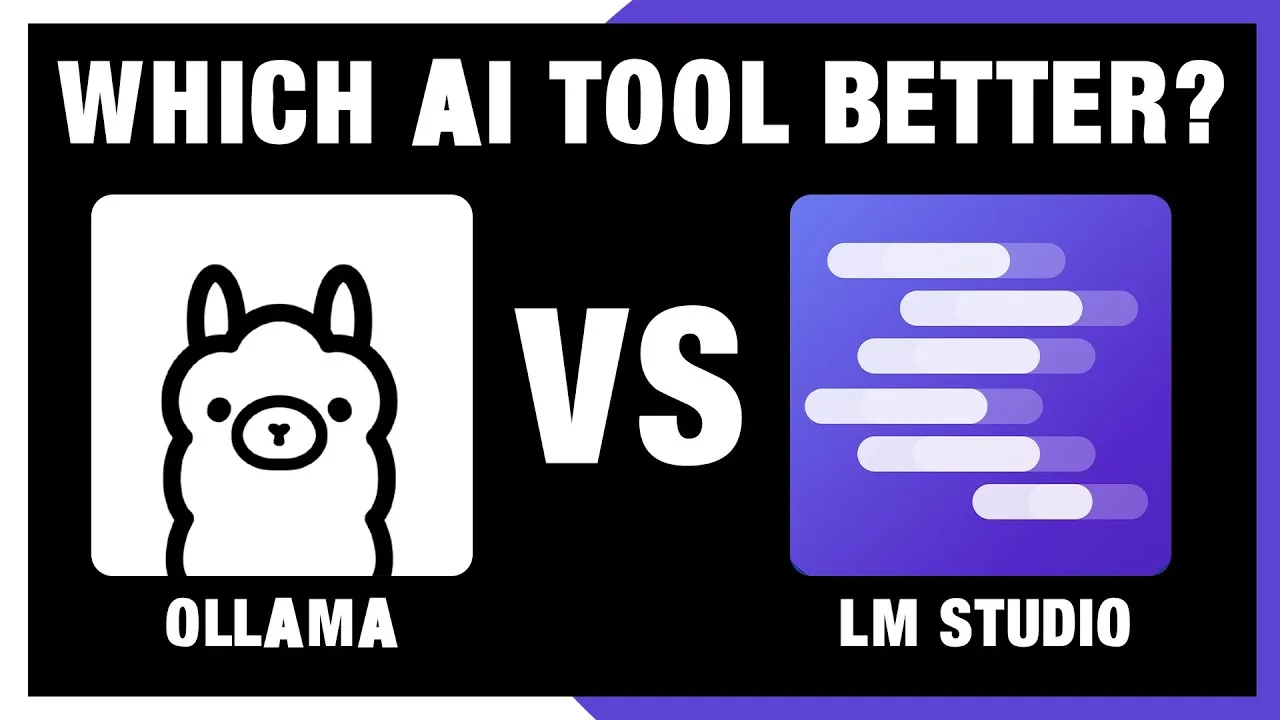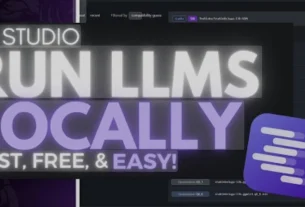Discover which local AI platform suits your needs best – from beginner-friendly interfaces to developer-focused customization
The race to run powerful AI models locally has never been more exciting. With privacy concerns mounting and the desire for unlimited AI access growing, two platforms have emerged as clear leaders: LM Studio and Ollama. But which one should you choose for your local AI journey?[1][3]
Both platforms enable you to run Large Language Models (LLMs) directly on your computer, offering enhanced privacy, reduced latency, and complete control over your data. However, they cater to distinctly different user preferences and technical requirements.[1][3]
What Are LM Studio and Ollama?
Both platforms simplify the complex process of running sophisticated AI models on personal computers, but they take fundamentally different approaches to user experience and functionality.[3]
LM Studio: The Visual Experience
LM Studio is a desktop application available for Windows, macOS, and Linux that prioritizes user-friendliness through its polished graphical interface. It’s designed as an all-in-one solution for discovering, downloading, and interacting with LLMs without requiring technical expertise.[3][4]
Ollama: The Developer’s Choice
Ollama operates primarily as a command-line interface (CLI) tool, offering greater flexibility and control for experienced users. It’s an open-source platform that runs on Windows, macOS, and Linux, providing extensive customization options through its REST API and configuration files.[2][3]
Feature-by-Feature Comparison
| Feature | LM Studio | Ollama | Winner |
|---|---|---|---|
| Primary Interface | Desktop GUI Application | Command-Line Interface | LM Studio (for GUI preference) |
| Ease of Setup | Simple install, point-and-click | Simple install, CLI commands | LM Studio (visual setup) |
| Model Discovery | Built-in Hugging Face browser | CLI commands, requires model names | LM Studio |
| Customization | Visual GUI settings | Modelfiles and API configuration | Tie (different approaches) |
| API Support | OpenAI-compatible local server | Full REST API integration | Ollama (more extensive) |
| Open Source | Closed-source (free for personal use) | Open-source (MIT license) | Ollama |
| Performance | Standard performance | 34.48% faster execution | Ollama |
| Resource Usage | Higher (full GUI application) | Lighter (background service) | Ollama |
LM Studio: Strengths and Weaknesses
✅ LM Studio Advantages
- Beginner-Friendly Interface: The GUI makes LM Studio exceptionally accessible, even for users with no prior LLM experience[3][4]
- Integrated Model Library: Built-in model discovery through Hugging Face integration simplifies finding and downloading models[4][6]
- Built-in Chat Interface: Immediate interaction with LLMs without additional setup requirements[3][5]
- Multi-Model Sessions: Load and compare outputs from different LLMs simultaneously[4]
- Visual Configuration: Easy parameter adjustment through graphical menus[5]
❌ LM Studio Limitations
- Limited Flexibility: Fewer customization options compared to Ollama’s extensive configuration capabilities[3][4]
- Closed-Source: Proprietary software with licensing requirements for commercial use[2]
- Higher Resource Usage: Full GUI application consumes more system resources[5]
- Less API Control: API designed primarily for local server use with limited configuration options[3]
Ollama: Strengths and Weaknesses
✅ Ollama Advantages
- Superior Performance: Significantly faster execution speeds – up to 34.48% better performance than LM Studio[2]
- Open-Source Freedom: MIT license allows unlimited use, modification, and commercial deployment[2][5]
- Extensive Customization: Modelfiles enable deep customization of model behavior and system configurations[3][5]
- Powerful API: Comprehensive REST API supports seamless integration with applications and workflows[3][5]
- Lightweight Operation: Minimal resource usage as a background service[5]
- Developer-Friendly: Excellent for scripting, automation, and building custom AI applications[3][5]
❌ Ollama Limitations
- Steeper Learning Curve: Command-line interface can intimidate users unfamiliar with terminal commands[3][5]
- Technical Expertise Required: Setup and configuration demand greater understanding of LLMs and system configurations[3]
- No Built-in Chat Interface: Requires third-party tools like Open WebUI for graphical interaction[3][6]
- Manual Model Discovery: Users must know specific model names rather than browsing through a visual catalog[5]
Performance Analysis: Speed Matters
Recent performance testing reveals a significant advantage for Ollama users. In controlled tests using the Qwen 2.5 1.5B model, Ollama consistently outperformed LM Studio:[2]
- Ollama Average: 141.59 tokens per second
- LM Studio Average: 92.7 tokens per second
- Performance Difference: Ollama is 34.48% faster
This performance gap becomes especially important for users running larger models or processing extensive conversations where response speed directly impacts user experience.[2]
Use Cases: When to Choose Which Platform
Choose LM Studio If You:
- Are new to local LLMs and prefer visual interfaces[3][4]
- Want immediate access to model discovery and download[4][5]
- Prioritize ease of use over advanced customization[3][4]
- Need built-in chat functionality without additional setup[3][5]
- Are exploring LLMs for learning or personal projects[4]
- Prefer point-and-click configuration over command-line tools[5]
- Want to compare multiple models simultaneously[4]
Choose Ollama If You:
- Are comfortable with command-line interfaces and prefer flexibility[3][5]
- Need maximum performance and speed from your local AI setup[2]
- Require extensive customization through Modelfiles and API configurations[3][5]
- Plan to integrate LLMs into custom applications or workflows[3][5]
- Value open-source software and community-driven development[2][5]
- Are building production applications that need reliable API access[3]
- Want to minimize system resource usage[5]
- Need commercial deployment flexibility[2]
Getting Started: Installation and Setup
LM Studio Setup Process
- Download LM Studio from the official website
- Install the application using the standard installer
- Launch LM Studio and browse the integrated model library
- Download your preferred model through the GUI
- Start chatting immediately through the built-in interface
Ollama Setup Process
- Install Ollama from the official website
- Open terminal/command prompt
- Pull your first model:
ollama pull llama3.1 - Run the model:
ollama run llama3.1 - Optionally install Open WebUI for a graphical interface
Advanced Features and Customization
LM Studio Advanced Features
- Local API Server: OpenAI-compatible API for integration with existing tools
- Model Comparison: Side-by-side testing of different models
- Parameter Adjustment: Visual sliders for temperature, top-p, and other settings
- Prompt Templates: Save and reuse custom prompt configurations
Ollama Advanced Features
- Modelfiles: Create custom model configurations with specific behaviors
- REST API: Full programmatic control over model execution
- System Integration: Easy scripting and automation capabilities
- Multi-GPU Support: Advanced hardware utilization options
Community and Support
Both platforms benefit from active, growing communities, but with different focuses:[2][3]
- LM Studio Community: Attracts users seeking user-friendly interfaces and model experimentation[2]
- Ollama Community: Strong developer focus with extensive documentation and API integration examples[2][3]
Cost Considerations
While both platforms are free for personal use, there are important licensing differences:[2]
- LM Studio: Free for personal use, requires commercial license for business applications
- Ollama: Completely free under MIT license, including commercial use
The Verdict: Which Platform Wins?
The choice between LM Studio and Ollama ultimately depends on your specific needs, technical comfort level, and project requirements.[3][4][5]
For Most Beginners: LM Studio
If you’re new to local AI and prefer visual interfaces, LM Studio provides the smoothest entry point into the world of local LLMs. Its integrated model discovery, built-in chat interface, and intuitive design make it ideal for learning and experimentation.[3][4]
For Developers and Power Users: Ollama
Developers, researchers, and users who need maximum performance and customization will find Ollama’s flexibility, speed advantages, and open-source nature more compelling. The superior performance and extensive API make it ideal for production applications.[2][3][5]
Future Considerations
As the local AI landscape continues evolving, both platforms are likely to improve. Ollama’s open-source nature enables rapid community-driven development, while LM Studio’s focus on user experience may lead to innovative GUI features.[3]
Consider starting with the platform that matches your current skill level, knowing that the experience gained with either tool will transfer well to other local AI platforms as your needs evolve.
Conclusion: Both Platforms Democratize AI
Both LM Studio and Ollama represent significant achievements in democratizing access to powerful AI technology. They each remove barriers to local AI deployment while serving different user preferences and technical requirements.[5]
The best choice isn’t about finding the “winner” – it’s about selecting the tool that aligns with your workflow, technical comfort level, and project goals. Whether you choose LM Studio’s user-friendly approach or Ollama’s powerful flexibility, you’ll be joining the growing movement toward private, local AI that puts control back in your hands.
Ready to start your local AI journey? Download either platform today and experience the freedom of running powerful language models on your own terms.



